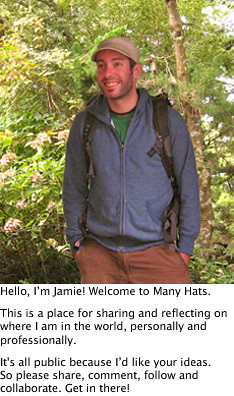Messing Around
I just finished reading “Living and Learning with New Media: Summary of findings from the digital youth project”, focusing in particular on their chapter that explored the media interaction stage of “Messing Around”. They define this as a stage of engagement with media that involves “tinkering, exploring and extending understanding.” and go into some detail to cite a range of examples where youth cultivate skills and interests in working with technology through only lightly purposeful exploration, that can then potentially develop into more focused and directional behaviours.
I fully agree that this sort of messing around is a valuable and possibly inevitable stage in the processes of exploring a new set of tools or potentials, but I definitely would argue that it is in no way unique to the fields of new media or online communications. Furthermore, though this article focuses on teenage youth, I don’t believe that the messing around stage is unique to this age group.
What struck me immediately was how their research connected with a post and comment I’d recently made on my classroom blog, here. In that post I discussed how:
Near the beginning of the year we always take time to really explore the tools of our classroom. Before students can be expected to use math tools and manipulatives for specific tasks, they need time to explore, experiment and play with them freely. This activity can teach me a lot about their approach to mathematical processes, and is a ton of fun for the class!
Clearly, what these seven year olds are doing is “messing around”. They tinker, they play, they use tools for purposes that they’ve seen done before, and they devise new ways to apply them as well. It’s often social and collaborative, or just as often the equivalent of someone sitting alone working something out.
Check out the manipulative play “messing around”:
Messing around is by no means just for new tech, or for math toys… It’s the way we begin to explore the parameters and potentials of any new set of tools, and it happens best when there is little external motivation or goal-setting, lots of time, and lots of opportunities to take risks.
Related
2 Responses to Messing Around
Leave a Reply Cancel reply
This site uses Akismet to reduce spam. Learn how your comment data is processed.
MY CLASS BLOG
This is my classy, yet personal blog. For my less personal –but perhaps classier– classroom blogs, click here, or here.MANY HATS in your inbox
Subscribe to Many Hats...

many hats by Jamie Raskin is licensed under a Creative Commons Attribution-NonCommercial-ShareAlike 3.0 Unported License.Details… details…
CATEGORIES
@jamieraskin
My TweetsINVASION PROGRESS




















































HISTORY
MANY COMMENTS









Great ideas, you reminded me that I see this type of messing around a lot when I offer an open computer lab time to the Grade 3 and 4 students one lunch time a week. They mess around for 40 minutes and have a ball! And they also find a lot of cool things to modify too (cursors, backgrounds, screen savers, etc.) Maybe I should incorporate it more into my lessons too as an introduction to the year? I like how you do it with the maths resources, I remember I always wanted to do that when I was at school but it was always used for more formal learning.
[…] discussed at length in an earlier Messing Around post, I believe fully in the need for this sort of experimental period across the curriculum. So […]